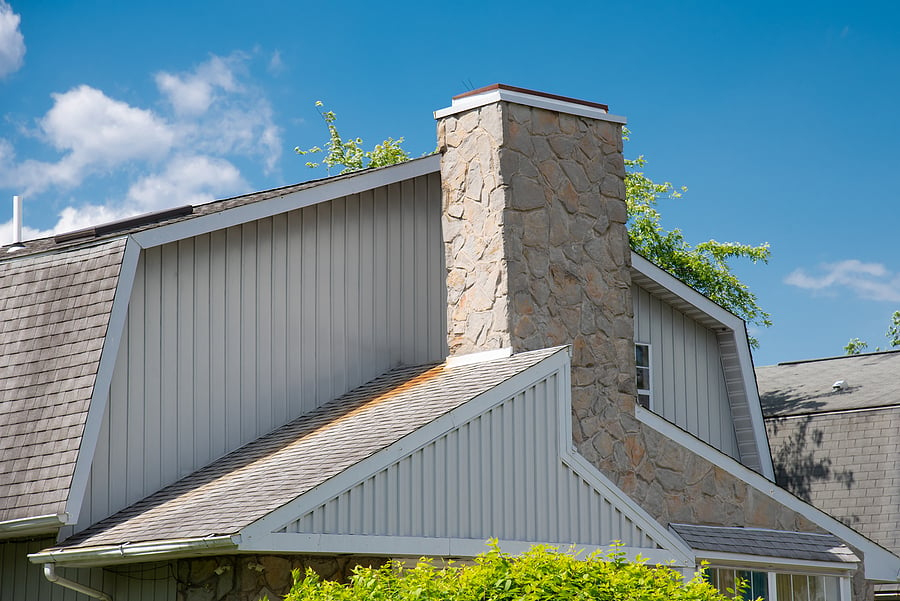Many homes these days have a chimney and a fireplace. They make for an incredible feature that provides comfort and warmth and gives your home a nice aesthetic. Whether you’re building a new home, remodeling your home with a chimney installation, or on the market to buy an existing home, understanding the different types of chimneys that are available and which chimney suits you and your home best is essential. Below, we’ll go over the basic functionality of a chimney and the six different types of chimneys out there.

How a Chimney Works
A chimney is a vertical pipe that directs the smoke accumulated in your fireplace out of your home. Chimneys were designed around the principle that hot air rises, and that concept is referred to as the stack effect or chimney effect. As your fire burns in your fireplace, it creates hot air and smoke. The air both inside and outside of your home and chimney is cooler than that of the smoke. Because hot air wants to be above cooler air, the air, or draft, accumulated in your fireplace travels up through the chimney and escapes your home. If you have a fireplace, you must have a chimney; otherwise, the smoke and particles that burn off in a fire will have nowhere to go and will build up in your home. Additionally, installing a chimney cap has significant benefits, such as preventing debris, rain, and animals from entering the chimney, which improves its overall function and longevity. These chimney cap benefits help maintain a cleaner and safer home environment.
Types of Chimneys
Regardless of the chimney you currently have, they all essentially work the same way. The different types of chimneys are:
1. Masonry Chimney
When you imagine a chimney, you’re most likely envisioning a masonry chimney. A masonry chimney is considered the standard chimney and it’s built with chimney rock, brick, stone, cement, or mortar. A masonry chimney helps heat other areas in your home because when the materials are used, especially brick, they absorb the heat from the smoke and fire and that heat is then radiated into other areas of your home. Masonry chimneys offer an elegant, sleek, and traditional aesthetic to your home and as an added bonus, tend to last a very long time – sometimes hundreds of years – especially when well cared for.
2. Metal Chimney
A metal chimney is built out of stainless steel and can either be double or triple-walled. They are typically built enclosed inside of a masonry chimney, a frame, or a wooden structure since they’re not as aesthetically pleasing. A double-walled metal chimney has insulation between the chimney and the walls. A triple-walled chimney doesn’t include extra insulation because the layers of the wall contain air between them for insulation.
3. Factory-Built Chimney
A factory-built or prefabricated chimney is a common chimney in newer homes. The name originated from the fact that the firebox in the fireplace that accompanies factory-built chimneys is fabricated from sheet metal and the chimney is entirely built in a factory before installation. In comparison, masonry chimneys are built onsite. Factory-built chimneys only work with factory-built fireplaces, which is important to note if you’re updating an existing fireplace and chimney. They also offer a vast array of material and color options, making them a great choice for modern homes. There are four types of factory-built chimneys to choose from which include: air-cooled, double-walled, air-insulated, and combination.
4. Fireplace Insert Chimney
A fireplace insert chimney is a stove that’s inserted into an existing opening, typically a masonry fireplace. The chimney connected to the stove insert connects to the existing chimney. These are perfect for homes that want a fireplace but don’t want an open one because they create an enclosed look.
5. Freestanding Stove Chimney
A freestanding stove chimney is custom-built to accompany a freestanding stove. Because the stove is freestanding, it provides a lot of versatility in style and placement. The custom-built chimney is typically a masonry chimney or factory-built chimney.
6. Wood-Burning Stove Chimney
Wood-burning stove chimneys were incredibly popular before the onset of electric and gas heat, as they burned heat to warm homes. These stoves have a metal pipe that comes out of the top of them, but these pipes aren’t chimneys because they can’t connect to the roof. The pipe usually connects to the wall, where it attaches to a chimney. These are great for homes that want more of a rustic look and if you prefer to heat your home without using gas or electric heat.
Now that you know the different options for chimneys, choosing which type of chimney for your home should be much easier. For more information about chimney repair, contact your local experts at Jack C. Wilson Roofing today!

